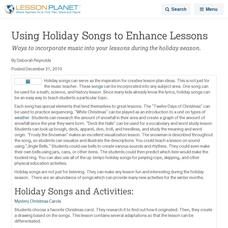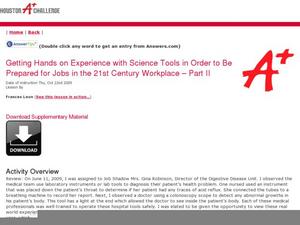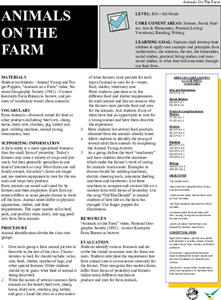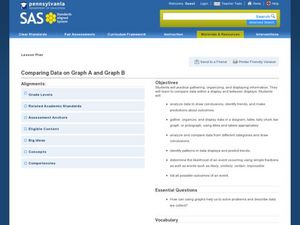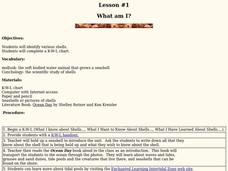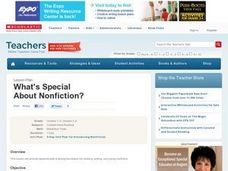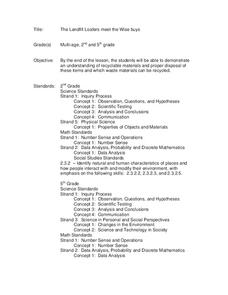Curated OER
Fairytale Cake
Learners recreate characters from the story, "The Fairytale Cake." In this fairy tale characterization lesson, students first listen to fairy tales read aloud. They then use play dough and plastic bowls as pretend "cakes and icing", and...
Curated OER
Jobs in the 21st Century
Young scholars understand the tools that will be used in the lab in the 21st century. In this job preparation lesson, students experiment and understand how to use lab equipment. Young scholars will write about the lab tools they've...
Alabama Wildlife Federation
Wildlife Habitat Checklist
Take a walk on the wild side with a project about animal habitats. After kids observe a chosen animal in its home, they describe the animal's food and water sources, shelter, and how it raises its young. They then write a short fictional...
Curated OER
American Flag History
Young historians explore US culture by investigating the US flag. They will use their textbooks, prior knowledge, and sources provided by the teacher to research the history of the American flag. They will design and create a trading...
Virginia Department of Education
Weather Patterns and Seasonal Changes
Get your class outside to observe their surroundings with a lesson highlighting weather patterns and seasonal changes. First, learners take a weather walk to survey how the weather affects animals, people, plants, and trees during...
John Lentine
Butterflies and Bugs
Symmetry, line, shape, art, and math are all connected through a fun hands-on craft. Included are instructions to a classic activity, where learners create butterflies to show symmetry in nature and then discuss symmetry in math. It is...
K5 Learning
The Moon
Second graders read a short informational text passage about the moon and answer a series of questions based on what they read.
Curated OER
Animals on the Farm
Students work in groups to create a description of a farm animal. Other classmates try to guess the animal. The class discusses what farmers need to provide for each animal on their farm (food, shelter, veterinary care). Students...
Curated OER
Alphabet Sideshow
Students practice sound and recognition of letters in alphabetical sequence. They gain an understanding of letter sounds and order. They create a slide show with graphics and text. They present their slide show to the class.
Curated OER
Telling Time as an Everyday Use of Numbers
How can we estimate time? Have your young mathematicians make a clock. Then they compare and contrast types of clocks. They practice writing times in two different ways and make a book about telling time.
Curated OER
Learning About Animal Shelters for Earth Day
Students explore habitats. in this ecology and animal habitat lesson, students listen to the book A House is a House for Me by Mary Ann Hoberman. Students discuss the basic needs of animals and go on a nature walk to observe animal...
Curated OER
The True Story of the Three Little Pigs
Students explore expressive reading. In this literature lesson, students read the book The True Story of the Three Little Pigs and interpret key themes. Students perform a different version of the text.
Curated OER
Comparing Data on Graph A and Graph B
Second graders gather and graph data. In this graphing instructional activity, 2nd graders collect data and graph this information using tally charts, bar graphs, pictographs, or tables. They make predictions about the outcomes.
Alabama Learning Exchange
On the Farm with Wilbur and Charlotte
Students understand Charlotte's web through the completion of a web-quest. In this Charlotte's Web lesson, students complete comprehension tasks such as role playing their favorite scene, choosing a character and making a multimedia...
Curated OER
Meet Matisse!
Second graders discover the life and works of French artist Henri Matisse in this one day, introductory lesson for the 2nd grade classroom. This first lesson can be used by itself or as the first day activity to a three to four day unit...
Curated OER
Animal Habitats
Learners research an animal and their habitat. In this animal habitat instructional activity, students observe a WebQuest that describes the different habitats: deserts, tundra, rainforest, forest, and ocean. They determine which habitat...
Curated OER
What Am I?
Students identify various shells. In this oceanography lesson, students create a KWL chart to activate background knowledge on shells. Students read the book Ocean Day and learn about waves, tides, and the seashells that can...
Curated OER
Fun with Fossils
Second graders explore the geologic process of fossil formation. In this geology instructional activity, 2nd graders discuss the job of a paleontologist and make their own model of a fossil. This instructional activity includes teacher...
Curated OER
What's Special About Nonfiction?
Students examine the difference between nonfiction and fictional writing. They identify the characteristics of nonfiction literature and examine how a nonfiction textbook organizes information.
Curated OER
The Landfill Loafers Meet the Wise Buys
Students discover recyclable materials and the proper disposal of those items through Internet research. Working in groups of four, they search the Internet for uses of recyclable materials. After research is complete, they participate...
Curated OER
Pansy Pig's Patience Pit
Students are introduced to the concepts of patience and anger. As a class, they are read a story about a patience pit and discover how anger can be controlled. They complete a worksheet and take a test to review how to control their...
Curated OER
See How They Grow: Plants And Their Parts
Students discuss what plants require in order to grow, identify plant parts and their functions and discuss a video about plants. They conduct a controlled experiment with bean seeds and then record and observe the bean plants.
Curated OER
Spend, Save or Donate
Students identify the difference between spending, saving, and donating. They brainstorm reasons to give and options to donate. They sing a song about donating to charity.



